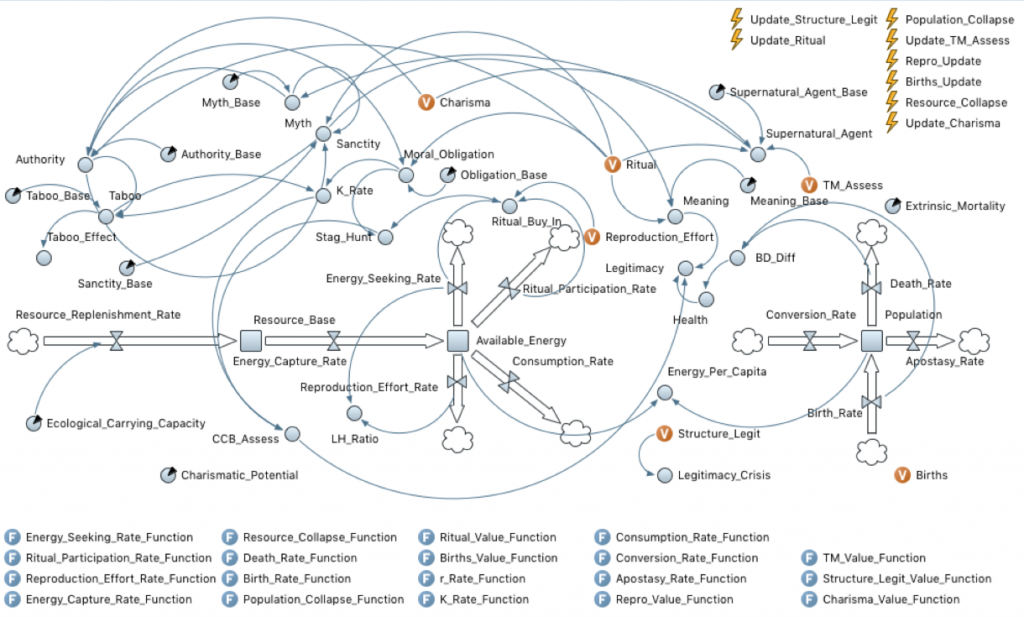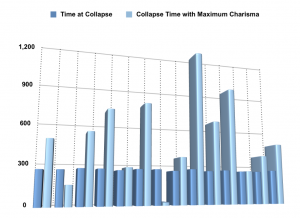From the Roman Empire to the USSR, even the most sophisticated societies eventually collapse, leaving behind ruins, a displaced populace, or (at best) a whole lot of unpleasant paperwork. But some societies last a lot longer than others. Why? One answer might come from examining an unexpected topic: religion.
Religious communities are intensely cooperative, require lots of commitment from their members, and center on unfalsifiable claims. In this way, they’re nearly prototypical human societies. Most importantly, many religious communities fail – in fact, the vast majority fizzle out after only a few years, and truly enduring religious institutions are rare but notable.
To learn about the difference between communities that fall apart and those that stick around, researchers at the Center for Mind and Culture (CMAC) built and tested a computer model of a religious community as a complex adaptive system. Experiments showed that religious groups that were higher in charismatic leadership – but lower in structural authority – survived longer before outstripping their resource base.
As part of the Modeling Religion Project, CMAC Postdoctoral Fellow Connor Wood collaborated with University of Connecticut anthropologist and CMAC Senior Research Associate Richard Sosis to build a system dynamics model (SDM) of a complex adaptive religious system, or a dynamic system that uses feedback and constant adjustments to adapt to changes in its environment. The simulated religious community existed in an environment with limited resources, which it could harvest to use for economic, reproductive, or ritual purposes. The more the community invested in ritual, the more entrenched its religious beliefs and worldview became. But when things weren’t going well – that is, if the community’s overall death rate surpassed its birth rate, or if it couldn’t harvest enough energy – the religious system began to lose legitimacy.

For some communities, these crises of legitimacy triggered a switch to “charismatic” forms of authority, centered on high levels of supernatural belief and lower levels of formal authority. For experiments, the simulation engine produced 16 different combinations of model parameters that maximized the community’s population at a given time. But when allowed to run to completion, many of these combinations led to social collapses shortly after the end of the original timeframe. Wood and Sosis then re-ran all 16 simulations with the value for a parameter called “Charismatic Potential” maximized. In 14 out of 16 cases, the simulated communities survived longer – in some cases, much longer.
In the simulation, the Charismatic Potential parameter governed how a crisis of legitimacy affected the religious community. If its value was high, the religious community would respond to a legitimacy crisis by suppressing normal, structural authority (the equivalent of a formal, priestly hierarchy) and cranking up levels of supernatural belief. Many anthropologists have found that charismatic, emotion-driven religious practices result from significant changes in the sociocultural environment. Wood and Sosis posited that this response may be an adaptive attempt to adjust to these changes.

Unexpectedly, lower levels of authority led to changes in the configuration of the rest of the system that kept it from outstripping its resource base. During this time societies looked more like cults than like normal religious communities – their core populations were very low, but they attracted a constant flow of interested converts who then quickly lost interest and departed.
This result makes intuitive sense, since cults often have high levels of charisma and low retention rates. But now we know that they might have an unanticipated effect on how the community lives within its ecological context.
The model was based on theoretical work by Sosis, whose previous research has examined the longevity of religious communes in 19th-century America. In that work, Sosis had discovered that religious communes that imposed higher costs on their members survived longer than those that were cheaper to join. But there’s more to community longevity than just investment barriers – religious communities also face challenges when their leadership loses credibility, or when their members can’t meet basic biological needs.
When religious communities lose legitimacy in this way, they can fall apart…or they adjust themselves by adapting to the new crisis. This realization led Sosis to conceive of religious communities as complex adaptive systems, or multilevel networks of social connections, practices, and cognitive factors that take in energy from their surroundings, reproduce themselves, and attempt to stay “alive” in the face of perturbations and challenges in their environments. This new simulation model attempted to explore the consequences of looking at religion from this angle – and ended up offering new insights into how societies stay alive.
For any inquiries or comments, please email admin@mindandculture.org.
